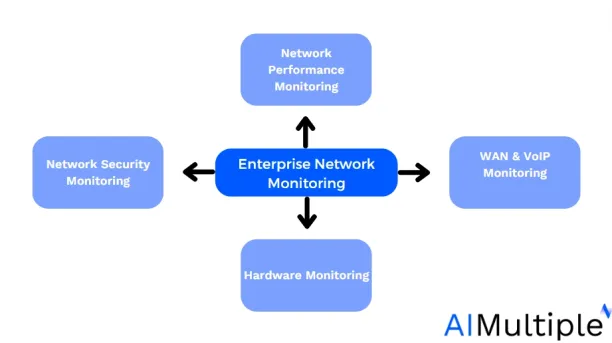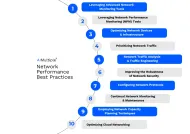Enterprise Network Monitoring in 2024: 7 Best Practices
Enterprise network monitoring is crucial for businesses, ensuring the smooth operation and security of their network infrastructure. This guide delves into enterprise network monitoring, its components, and best practices to optimize its use for the benefit of businesses.
If you are looking for a network monitoring tool, check out our vendor benchmark.
What is enterprise network monitoring?
Enterprise network monitoring is an integral process that involves the continuous observation and management of an organization’s network infrastructure. It’s a systematic approach to oversee all network devices, ensuring they function optimally and securely. This monitoring encompasses a wide range of activities, from analyzing network traffic flows to maintaining network security, and plays a vital role in the stability and efficiency of enterprise networks.
Through the use of sophisticated network monitoring systems, organizations can proactively address issues, optimize network performance, and maintain robust security standards. By deploying a comprehensive network monitoring solution, businesses can ensure their networks are resilient, efficient, and aligned with their operational needs.
If you are looking for free network monitoring tools that align with the best practices discussed in this article, consider exploring our guide ‘Top 7 Free Network Monitoring Tools.‘ This resource offers a selection of effective solutions that can help you enhance your network management without incurring additional costs.
What is included under enterprise network monitoring?

Enterprise network monitoring is not a singular activity but a complex of various monitoring facets, each playing a significant role in the overall health of the network.
Network performance monitoring
At the heart of enterprise monitoring is network performance monitoring. This involves tracking and analyzing the flow of network traffic to ensure the network operates at peak efficiency. Monitoring tools here are designed to detect and report issues like bandwidth bottlenecks, latency problems, and packet loss. These insights help network administrators make informed decisions to enhance network performance and reliability.
Hardware monitoring
Network infrastructure is only as strong as its weakest link, which often comes down to the physical hardware. Hardware monitoring focuses on the health and status of all physical devices within the network. By keeping a close eye on these network devices, businesses can preemptively identify and rectify hardware malfunctions before they escalate into more significant issues.
Using a network monitoring tool enables you to:
- Detect performance problems stemming from hardware malfunctions.
- Track hardware indicators such as power levels, temperature readings, and voltage values.
- Enhance the management of resource distribution and strategize for capacity planning.
WAN & VoIP monitoring
With businesses increasingly relying on wide area networks (WAN) and Voice over Internet Protocol (VoIP) services, monitoring these aspects has become essential. WAN monitoring looks at the performance and reliability of external network connections, while VoIP monitoring ensures that voice communications are clear, reliable, and uninterrupted.
Network security monitoring
This involves scrutinizing network traffic and activities to detect and mitigate potential security threats. From unauthorized access attempts to suspicious data transfers, security monitoring tools play a critical role in protecting sensitive network data and maintaining the integrity of enterprise networks.
What are the best practices for enterprise network monitoring?
1- Comprehensive Coverage
Ensure that all aspects of the network, including every device and traffic flow, are under constant surveillance. Utilizing network maps can provide a visual overview, aiding in the identification of potential issues.
2- Utilization of the Simple Network Management Protocol (SNMP)
SNMP is a vital protocol for managing and monitoring network devices. It allows for the collection and organization of information about managed devices on IP networks and is essential for effective network monitoring.
3- Regular Updates and Maintenance
Keeping monitoring tools and systems updated is crucial. Regular updates ensure that the tools are equipped with the latest features and security measures to handle emerging threats and technologies.
4- Customized Alerts and Notifications
Configuring alerts and notifications to suit specific organizational needs ensures that network administrators are promptly informed of any issues, allowing for quick response and resolution.
5- Data Analysis and Reporting
Regularly analyze network data to identify trends and patterns. This can aid in future planning, capacity management, and identifying areas needing improvement.
6- Scalability and Flexibility
As businesses grow, so do their network needs. An effective network monitoring solution should be scalable and flexible, able to adapt to changing requirements without compromising performance.
7- User Training and Awareness
Ensuring that network administrators and relevant personnel are well-trained and aware of the monitoring tools and practices is essential for the effective monitoring of enterprise networks.
For more on network monitoring
- Network Performance Monitoring to Maximize Business Efficiency in 2024
- Top 5 Network Performance Monitoring Tools in 2024
- 10 Network Performance Best Practices to Improve Network Optimization
- 26 Network Performance Metrics to Measure Network Health in 2024
If you have questions or need help in finding vendors, reach out:

Cem is the principal analyst at AIMultiple since 2017. AIMultiple informs hundreds of thousands of businesses (as per Similarweb) including 60% of Fortune 500 every month.
Cem's work has been cited by leading global publications including Business Insider, Forbes, Washington Post, global firms like Deloitte, HPE, NGOs like World Economic Forum and supranational organizations like European Commission. You can see more reputable companies and media that referenced AIMultiple.
Throughout his career, Cem served as a tech consultant, tech buyer and tech entrepreneur. He advised enterprises on their technology decisions at McKinsey & Company and Altman Solon for more than a decade. He also published a McKinsey report on digitalization.
He led technology strategy and procurement of a telco while reporting to the CEO. He has also led commercial growth of deep tech company Hypatos that reached a 7 digit annual recurring revenue and a 9 digit valuation from 0 within 2 years. Cem's work in Hypatos was covered by leading technology publications like TechCrunch and Business Insider.
Cem regularly speaks at international technology conferences. He graduated from Bogazici University as a computer engineer and holds an MBA from Columbia Business School.
Sources:
AIMultiple.com Traffic Analytics, Ranking & Audience, Similarweb.
Why Microsoft, IBM, and Google Are Ramping up Efforts on AI Ethics, Business Insider.
Microsoft invests $1 billion in OpenAI to pursue artificial intelligence that’s smarter than we are, Washington Post.
Data management barriers to AI success, Deloitte.
Empowering AI Leadership: AI C-Suite Toolkit, World Economic Forum.
Science, Research and Innovation Performance of the EU, European Commission.
Public-sector digitization: The trillion-dollar challenge, McKinsey & Company.
Hypatos gets $11.8M for a deep learning approach to document processing, TechCrunch.
We got an exclusive look at the pitch deck AI startup Hypatos used to raise $11 million, Business Insider.
To stay up-to-date on B2B tech & accelerate your enterprise:
Follow on


Comments
Your email address will not be published. All fields are required.